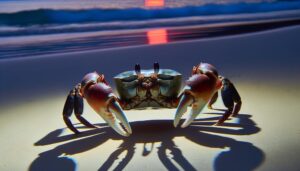Understanding the Amelia Earhart Coconut Crab Theory
The Amelia Earhart coconut crab theory posits that after possibly crash-landing on Nikumaroro Island, her remains were consumed by coconut crabs. These large arthropods exhibit scavenging behavior, particularly nocturnal foraging for carrion.
Forensic evidence includes skeletal remains found in 1940 and artifacts suggesting her presence. Observational studies of crabs scavenging flesh support this hypothesis.
However, the lack of definitive physical evidence and behavioral inconsistencies invite skepticism. Ongoing interdisciplinary analysis and archaeological investigations continue to explore this intriguing concept.

Key Takeaways
- Coconut crabs are suspected to have scavenged Earhart's remains due to their documented behavior of foraging for carrion.
- Human skeletal remains were found on Nikumaroro Island, potentially linked to Earhart through forensic analysis.
- Radio distress signals from Earhart's plane aligned with the location of Nikumaroro Island.
- Experiments with pig carcasses demonstrated coconut crabs' capability to dismantle remains, supporting the theory.
- Despite extensive searches and artifact discoveries, no conclusive evidence has definitively confirmed Earhart's fate on Nikumaroro Island.
Earhart's Final Flight
Amelia Earhart's final flight commenced on July 2, 1937, when she and navigator Fred Noonan departed from Lae, New Guinea, in their Lockheed Electra aircraft.
The objective was to reach Howland Island, located approximately 2,556 miles away. Earhart's meticulously planned route included radio communication checkpoints to aid navigation.
However, during the flight, multiple transmission issues arose, leading to intermittent and unclear communications with the US Coast Guard cutter Itasca stationed near Howland Island. Despite exhaustive efforts to establish contact, Earhart's final position couldn't be determined.
Atmospheric conditions, coupled with potential navigational errors, likely contributed to the loss of their bearings. The disappearance prompted an extensive search operation, but no conclusive evidence of the aircraft or its occupants was found.
The Nikumaroro Island Mystery
The Nikumaroro Island mystery centers on the hypothesis that Earhart and Noonan may have crash-landed on this remote atoll in the central Pacific Ocean. Investigations have revealed several artifacts and human remains on the island, suggesting a possible connection.
Forensic analysis of bones discovered in 1940 showed measurements consistent with Earhart's physique. Additionally, a piece of aluminum debris found on the island matches the construction material of Earhart's Lockheed Electra aircraft. Radio distress signals received shortly after their disappearance also align with the island's location.
Despite extensive searches, no conclusive evidence has been established. The theory remains one of the most plausible explanations for their fate, fueling continued interest and research into the disappearance.
Coconut Crabs' Behavior
Coconut crabs, the largest terrestrial arthropods, exhibit complex behaviors including climbing trees, cracking open coconuts, and scavenging for food, which might provide insights into their potential interaction with human remains. These crabs, Birgus latro, are known for their formidable claws capable of exerting significant force, allowing them to access various food sources. Their nocturnal activity patterns include foraging for carrion and other organic material. Observations show that coconut crabs possess a keen sense of smell, aiding them in locating decomposing matter over substantial distances.
| Behavior | Description |
|---|---|
| Climbing | Ascend trees to retrieve coconuts |
| Cracking Coconuts | Use powerful claws to break open coconuts |
| Scavenging | Forage for carrion and organic matter, guided by olfaction |
This behavioral repertoire supports their adaptability to diverse ecological niches.
Evidence Supporting the Theory
Given the coconut crabs' documented behaviors, several pieces of evidence suggest their involvement in the disappearance of human remains on Nikumaroro Island. Researchers have observed coconut crabs demonstrating the ability to scavenge and consume flesh, including bones.
On Nikumaroro, skeletal remains attributed to a human were discovered in 1940; however, only partial bones were found, raising questions about their dispersal. The presence of coconut crabs in large numbers on the island aligns with the hypothesis that they could have moved and fragmented the remains over time.
Additionally, experiments where pig carcasses were placed on the island have shown that coconut crabs can rapidly disarticulate and scatter bones, further supporting the theory of their involvement in the disappearance.
Skepticism and Controversy
Many experts question the validity of the coconut crab theory, citing a lack of conclusive evidence linking the crabs directly to the disappearance of Amelia Earhart's remains. Skepticism arises from several critical points:
- Absence of definitive physical evidence: No remains conclusively identified as Earhart's have been found.
- Crab behavior inconsistencies: While coconut crabs can consume flesh, their scavenging patterns vary widely.
- Alternative theories: Competing hypotheses, such as crash-and-sink or capture by Japanese forces, possess substantial support.
- Historical and forensic analysis: Existing bone fragments and artifacts lack definitive links to Earhart.
These points underscore the controversy surrounding the coconut crab theory. The complexity of Earhart's disappearance necessitates a cautious, evidence-based approach to any conclusions, highlighting the need for further interdisciplinary investigation.
Conclusion
Earhart's final flight remains shrouded in mystery, her fate intertwined with the enigma of Nikumaroro Island. The behavior of coconut crabs—omnivorous scavengers with a penchant for flesh—provides a plausible, albeit grim, explanation.
Evidence such as skeletal remains and personal artifacts supports this theory. However, skepticism persists, fueled by the lack of definitive proof.
Consequently, Earhart's disappearance continues to captivate, challenge, and confound both historians and aviation enthusiasts alike.






